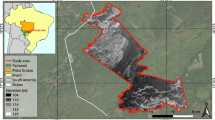Abstract
This study aims to interpret and analyze images of forest fires and to establish a standard procedure for image processing and interpretation. A forest fire in Victoria, Australia, that occurred in 2009 is used as an example. The extent of the disaster can be analyzed from Formosat-2 images and ALI data. The results show that fire distribution information can be quickly retrieved through scatter plots created by ALI’s red and short-wave infrared channels. The burn zones can be rapidly identified from a combination of these wave bands. Moreover, the process of the life of the fire can be deduced through smoke information and changes in the burn zones observed from the images. The maximum likelihood method and K-means method are adopted to rapidly determine the sizes and ranges of the burn zones. The precision obtained by applying this method to images influenced by smoke is 75.74 %, while that without the influence of smoke is 81.92 %.

















Similar content being viewed by others
References
Atkinson D, Chladil M, Janssen V et al (2010) Implementation of quantitative bushfire risk analysis in a GIS environment. Int J Wildland Fire 19:649–658
Australian Government Bureau of Meteorology (2003) Bushfire weather
Cao X, Chen J, Matsushita B, Imura H, Wang L (2009) An automatic method for burn scar mapping using support vector machines. Int J Remote Sens 30:577–594
Dennison PE, Roberts DA (2009) Daytime fire detection using airborne hyperspectral data. Remote Sens Environ 113:1646–1657
Dennison P, Charoensiri K, Roberts D, Peterson S, Green R (2006) Wildfire temperature and land cover modeling using hyperspectral data. Remote Sens Environ 100:212–222
Fraser RH, Li Z, Cihlar J (2000) Hotspot and NDVI differencing synergy (HANDS): a new technique for burned area mapping over boreal forest. Remote Sens Environ 74:362–376
Giglio L, Kendall JD (2001) Application of the Dozier retrieval to wildfire characterization—a sensitivity analysis. Remote Sens Environ 77:34–49
Joyce KE, Belliss SE, Samsonov SV, McNeill SJ, Glassey PJ (2009) A review of the status of satellite remote sensing and image processing techniques for mapping natural hazards and disasters. Prog Phys Geogr 33:183–207
Justice CO, Korontzi S (2001) A review of the status of satellite fire monitoring and the requirements for global environmental change research, SPB Academic Publishing bv {a}
Justice CO, Giglio L, Korontzi S, Owens J, Morisette JT, Roy D, Descloitres J, Alleaume S, Petitcolin F, Kaufman Y (2002) The MODIS fire products. Remote Sens Environ 83:244–262
Kaufman YJ, Justice CO, Flynn LP, Kendall JD, Prins EM, Giglio L, Ward DE, Menzel WP, Setzer AW (1998) Potential global fire monitoring from EOS-MODIS. J Geophys Res Atmos 103:32215–32238
Koutsias N, Karteris M (1998) Logistic regression modelling of multitemporal Thematic Mapper data for burned area mapping. Int J Remote Sens 19:3499–3514
Lentile LB, Holden ZA, Smith AMS, Falkowski MJ, Hudak AT, Morgan P, Lewis SA, Gessler PE, Benson NC (2006) Remote sensing techniques to assess active fire characteristics and post-fire effects. Int J Wildland Fire 15:319–345
Leonard JE, McArthur NA (1999) A history of research into building performance in Australian bushfires. Paper presented
Lillesand TM, Kiefer RW (1994) Remote sensing and image interpretation, 3rd edn. Wiley, New York
Lin ML (2011) Using GIS-based spatial geocomputation from remotely sensed data for drought risk-sensitive assessment. Int J Innov Comput Inform Control 7(2):657–668
Lin CW (2012) The construction of a high-resolution visual monitoring for hazard analysis. Nat Hazards. doi:10.1007/s11069-012-0409-9
Liu CC, Liu JG, Lin CW, Wu AM, Liu SH, Shieh CL (2007) Image processing of FORMOSAT-2 data for monitoring the South Asia tsunami. Int J Remote Sens 28:3093–3111
Liu CC, Wu AM, Yen SY, Huang CH (2009) Rapid locating of fire points from Formosat-2 high spatial resolution imagery: example of the 2007 California wildfire. Int J Wildland Fire 18:415–422
Long M (2006) A climatology of extreme fire weather days in Victoria. Aust Meteorol Mag 55:3–18
Lowell K, Shamir R, Siqueira A et al (2009) Assessing the capabilities of geospatial data to map built structures and evaluate their bushfire threat. Int J Wildland Fire 18:1010–1020
Lucas C (2007) Bushfire weather in Southeast Australia: recent trends and projected climate change impacts. CRC, Bushfire
McMichael AJ, Woodruff RE, Hales S (2006) Climate change and human health: present and future risks. Lancet 367:859–869
Metternicht G (2003) Vegetation indices derived from high-resolution airborne videography for precision crop management. Int J Remote Sens 24(14):2855–2877
Morisette J, Giglio L, Csiszar I, Justice C (2005) Validation of the MODIS active fire product over Southern Africa with ASTER data. Int J Remote Sens 26:4239–4264
Pan KL (2006) Remote sensing outline: remote sensing concept, principles and interpretations of imaging techniques. Scientific & Technical Publishing Co., Ltd
Pyne S, Andrews P, Laven R (1996) Introduction to wildland fire. Wiley, New York
Salvador R, Valeriano J, Pons X, Diaz-Delgado R (2000) A semi-automatic methodology to detect fire scars in shrubs and evergreen forests with Landsat MSS time series. Int J Remote Sens 21:655–671
Sharples JJ (2009) An overview of mountain meteorological effects relevant to fire behaviour and bushfire risk. Int J Wildland Fire 18:737–754
Sim M (2002) Bushfires: are we doing enough to reduce the human impact? Occup Environ Med 59:215–216
Sullivan AL (2009) Wildland surface fire spread modelling, 1990–2007. 3: simulation and mathematical analogue models. Int J Wildland Fire 18:387–403
Thomas PJ, Nixon O (1993) Near-infrared forest fire detection concept. Appl Opt 32:5348–5355
Thornton PR (2011) Short communication on research response to the Black Saturday (7th February 2009) Victorian Bushfires. Aust Fire Technol 47:295–301
Acknowledgments
The authors would like to thank Dr. the National Science Council of the Republic of China, Taiwan, for their financial support of this research under Contract Nos. NSC 101-2627-B-006-013, NSC 101-2611-M-006-002, and 100-2628-E-022-002-MY2. We would like to thank Daniel Irwin and Stuart Frye for providing ALI data and analysis.
Author information
Authors and Affiliations
Corresponding author
Rights and permissions
About this article
Cite this article
Liu, C.C., Kuo, Y.C. & Chen, CW. Emergency responses to natural disasters using Formosat-2 high-spatiotemporal-resolution imagery: forest fires. Nat Hazards 66, 1037–1057 (2013). https://doi.org/10.1007/s11069-012-0535-4
Received:
Accepted:
Published:
Issue Date:
DOI: https://doi.org/10.1007/s11069-012-0535-4




